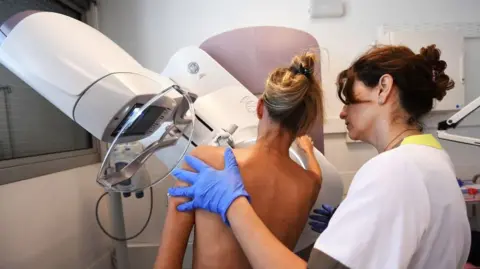The debate surrounding who should be allowed to perform mammograms has gained momentum, especially in light of significant staff shortages within the field of radiography. Recent statements from the Society of Radiographers (SoR) advocate for a policy change that would permit male health workers to conduct breast screening examinations. This proposal arises from the pressing need to address a critical shortage of radiographers specializing in mammography, an essential service that aims to detect breast cancer early, particularly among women aged 50 to 71, who are offered X-ray screenings every three years.
Currently, mammograms are exclusively conducted by female staff, a practice rooted in historical norms and cultural sensitivities. However, the SoR has emphasized that evolving circumstances merit a reevaluation of this policy. Sally Reed, a 67-year-old woman who underwent two mastectomies following mammograms that revealed breast cancer, voiced strong support for the idea of introducing male radiographers into this space. In her remarks, Reed noted, “If something can save your life, you should go for it,” underscoring that the gender of the radiographer should not overshadow the importance of the medical intervention being provided.
As the discussion unfolds, it has become evident that the current staffing crisis significantly hampers the efficacy of breast cancer screenings. With a vacancy rate of approximately 17.5% among specialized mammographers, and even higher in specific fields involving assessment for lumps or family histories of breast cancer, the urgency to attract new personnel is palpable. This shortage can delay crucial diagnoses and diminish the overall effectiveness of screening programs, with many qualified candidates feeling excluded due to the gender-specific stipulations currently in place.
The annual SoR conference was a pivotal moment for discussing potential changes in this regard. Topics such as whether transgender men should be included in the National Health Service (NHS) breast screening program brought to light the broader implications of gender inclusion in healthcare. Sue Johnson, a representative from SoR, stated that the role of the radiographer has undoubtedly evolved over time. She highlighted the comprehensive nature of the job, which now extends well beyond merely capturing images, suggesting that allowing male practitioners could not only alleviate staffing shortages but also attract more diverse talent into the profession.
Moreover, Johnson expressed optimism about shifting public perceptions, arguing that the societal landscape has changed significantly, making it an opportune time to reconsider who is qualified to perform mammograms. The notion that men could provide these essential services does not challenge traditional boundaries but rather reflects ongoing advancements in healthcare equity and inclusivity. This perspective aligns with Reed’s sentiment, as she noted that given her life-saving experience with mammograms, the gender of the radiographer would have made no difference in her desire for effective cancer screening.
While support for this proposal seems to be growing, challenges remain. Reed admitted that many women who already harbor reservations about attending breast screenings may feel even more deterred if approached by a male staff member. This reality underscores the need for comprehensive outreach and education to mitigate potential apprehensions surrounding male involvement in this sensitive area of healthcare.
The discussions initiated at the SoR conference and experiences shared by individuals like Reed highlight a crucial juncture in breast cancer screening practices, suggesting that including male health workers could redefine the landscape of radiography and ultimately enhance the quality of care provided to women. The conversations are far from over, but they represent a significant step towards incorporating diverse perspectives in addressing systemic healthcare challenges. The future of mammogram screenings may indeed depend on this progressive thinking and willingness to adapt to the changing dynamics of healthcare workforce requirements.



